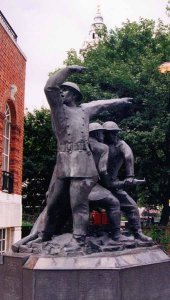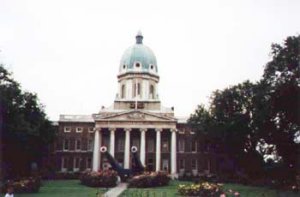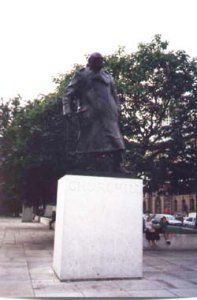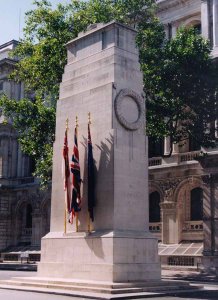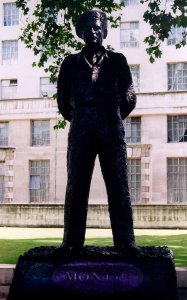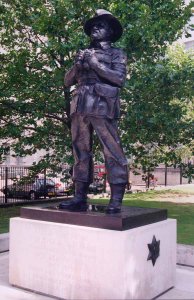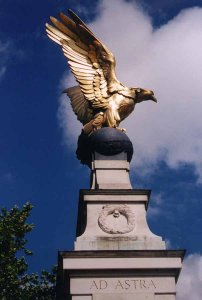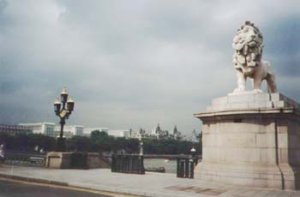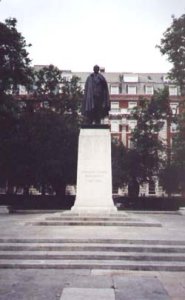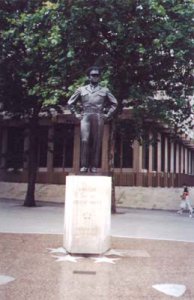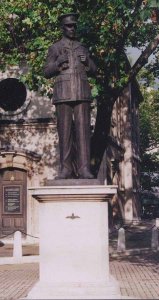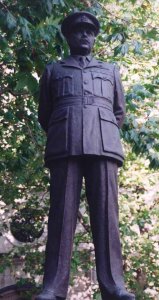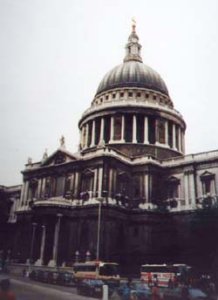
"This is London"
by Richard Doody
with additional photos by William Sooby
|
With the fall of France and continued American neutrality, the British Empire remained the last impediment to Axis world domination in the summer of 1940. London, the capital of this empire which still ruled a quarter of the worldís population, became the nerve center of the forces fighting against Hitler and his partners. In addition to its own administration, the city housed the governments-in-exile, deposed monarchs and resistance movements of a dozen occupied nations for the duration of the conflict. The worldís most populous city became more so. Refugees from the continent had begun to arrive shortly after the Nazi takeover of Germany in 1933 and as the political and religious persecutions accelerated so did the flood of exiles. The German conquerors slowed but never entirely stopped the movement of their human opponents to the ancient Roman city on the Thames. London was the target of incessant aerial bombardment during the months that followed the French defeat. Hitler hoped the bombing would quickly weaken British resolve and lead to their capitulation but failing that it would serve to soften up the island for Operation Sealion. Sealion would attempt to replicate a feat last successfully accomplished by William the Conqueror in 1066, the invasion of Britain from the continent. The city; particularly the port, industrial and working class districts in the Eastend, was hit night and day. The social conflict arising from an uneven distribution of the terror abated somewhat after Churchill overrode the censors and allowed the press to report the bombing of Buckingham Palace. The Battle of Britain came to a sudden conclusion on June 22, 1941. Hitler turned his attention eastward and attacked his former partner, the Soviet Union.
The sounds and images of what Londoners called "The Blitz" echoed in the homes of a still wavering America nightly. Edward R. Murrow roamed the streets and rooftops of the burning metropolis broadcasting eyewitness accounts of the city and its citizens under siege back across the Atlantic. No one who heard his reports will ever forget the deep booming voice that began each broadcast with the words, "This is London.". Murrow and his colleagues did their utmost to sway American opinion in favor of Britain but it was the Japanese attack on Pearl Harbor and declarations of war by Hitler and Mussolini in December, 1941 that finally forced the United States into active participation in World War II. The mutual assistance pact, fostered by Churchill and Roosevelt, which heretofore amounted to food, arms and policy initiatives became a full fledged alliance. American forces arrived in Britain by the thousands and General Eisenhower, the Supreme Commander of Allied Forces in Europe, established his headquarters in London. The success of the Normandy invasion and the rapid Allied advance through France should have given Londoners a bit of breathing space but the German dictator had a new weapon in his arsenal. London became the target of a last desperate attempt to change the course of events. Death poured once more from the skies above the capital. The "buzz bomb" attacks began in the summer of 1944 and continued until the closing days of the war in Europe. The war in Europe concluded with an unconditional German surrender signed on May 7, 1945 in a schoolhouse in Reims. On VE Day Londoners paused for a brief moment of celebration before resuming the tasks of concluding the war in the Pacific and rebuilding a shattered world. Jubilant crowds gathered in Piccadilly Circus, Trafalger Square and beneath the windows of Buckingham Palace where Winston Churchill appeared with the royal family to make the formal announcement of Germanyís defeat and the cityís return to peace. A TOUR OF LONDONíS WORLD WAR II MEMORIALS & MUSEUMSTime and progress have done much to alter the face of Britainís capital in the half century since the conclusion of World War II but much remains as it was in the days when Churchill, Eisenhower, Murrow and a host of equally noteworthy figures made the metropolis the center of the free world. The worthy relics of Londonís proud past have since been supplemented by a number of impressive memorials and museums that focus oneís thoughts on this heroic era.
Visitors in search of the city as it was in wartime can find no better place to begin their quest than the Imperial War Museum. It is, perhaps, appropriate that a museum dedicated to the dissemination of knowledge concerning mankindís worst folly should be housed in a former mental institution. The building of the Royal Bethlehem Hospital or "Bedlam" was completed in 1815. The displays focus not only on the horrors and heroics of the battlefield but also on effects of modern warfare upon society at large. The Blitz Experience,a reconstruction of an air raid shelter and bombed streetfront, stirs the consciousness with the terrible sights, sounds and smells of the city under attack. Our tour of the cityís memorials begins in Westminster Abbey, scene of English coronations since the time of William the Conqueror. Beneath the west window of the nave "rests the body of a British warrior, unknown by name or rankÖThey buried him among the kings because he had done good toward God and toward his house." The Tomb of the Unknown Warrior was dedicated on Armistice Day, 1920 by King George V. The carnage of the Great War took the lives of over one million British Empire troops. The memory of this horror was never far from a generation of Britons who cheered when Neville Chamberlain returned from Munich with a hallow promise of peace for their time. It would be a short peace. The Royal Air Force Chapel at the east end of the Abbey commemorates "the few" who kept Britain free. The chapelís Battle of Britain window designed by Hugh Easton incorporates scenes from that decisive contest and crests of the 68 RAF fighter squadrons that participated in it.
Behind the Abbey in Parliament Square stands a statue of Winston Churchill by Ivor Roberts-Jones. The Prime Ministerís likeness faces the Palace of Westminster (parliament). The palace was badly damaged during the Blitz. The Luftwaffe scored a direct hit on the debating chambers of the House of Commons. It was there that Sir Winston delivered some of his finest orations, first as a lonely back bench opponent of the appeasers and later as His Majestyís first minister from May 1940 to June 1945. Jacob Epsteinís statue of Field Marshall Jan Christian Smuts, wartime Prime Minister of the Union of South Africa, stands in another corner of the square.
Whitehall, running north between Parliament and Trafalger Squares, is lined with government ministries and a number of noteworthy memorials. The Cenotaph was designed by Sir Edwin Lutyens as a memorial to the dead of the Great War. It was first built in plaster as served as a reviewing stand for the victory parade in 1919. It was rebuilt in Portland stone a year later. An additional inscription honoring the dead of World War II was unveiled in 1946 by George VI. The monument is the scene of wreath laying ceremony each year on the Sunday preceding Armistice Day. Raleigh Green, the back lawn of the Defence Ministry, is graced with the presence of two Field Marshals. The statue of Viscount Montgomery of Alamein, Commander of the British 8th Army, is by Oscar Nemon. That of Viscount Slim, Commander of the British 14th Army, is by Ivor Roberts-Jones. Downing Street, home of Britainís Prime Ministers, intersects Whitehall across from Raleigh Green. The street is closed to visitors for security reasons. Whitehall ends in Trafalger Square. The great plaza surrounding Nelsonís column has changed little since the time when Ed Murrow stood on the steps of Saint Martin in the Fields to report the sights and sounds of the city at war back to a still uncertain America. The images he transmitted; the searchlights scanning the skies for the Luftwaffe, the whine of air raid sirens, the pop pop of anti-aircraft batteries and the heroic attempts of Londonís firefighters to douse the flames, remain vivid in the memories of all who heard them.
Northumberland Avenue connects the square with the Victoria Embankment which follows the Thames to the east. Follow the Embankment south to the statue of Viscount Portal of Hungerford, Air Marshal Charles F. A. Portal, Chief of Air Staff 1939-í45. The sculpture by Oscar Nemon stands in front of the Defence Ministry. The Royal Air Force Memorial, crowned by Sir William Reid Dickís gilt eagle, faces the Thames a bit further down. A memorial to General Wingateís Chindit Special Force, commandos who fought the Japanese in Burma, stands in front of the Canon Row police station. A mythical Burmese dragon, a Chindit, sculpt by Frank Forster, roars defiance from atop the monument.
The Embankment ends at Westminster Bridge. Queen Boadicea in her horsedrawn chariot guards the bridgeís western approach. Boadicea led the Iceni in a failed rebellion which aimed to free Britain from Roman rule. The eastern approach is guarded by the Coade stone lion. W. F. Woodington carved this rendition of the British national beast in 1837 for the Lion brewery. The brewery was demolished to make way for the Royal Festival Hall site of the 1951 Festival of Britain which was staged to mark the centennial of the Great Exposition at the Crystal Palace and Britainís recovery from wartime privations. The lion was preserved as decoration for the festival and moved to its present lair at the exhibitionís close. Food rationing continued in Britain until 1954. The building just behind the lion is the London County Council hall. A monument to the British volunteers who served in the International Brigades fighting on the Republican side in the Spanish Civil War is located at the north end of the hall. Return to the west bank and continue on past Parliament Square. Turn north on the Horse Guards Road and enter the Cabinent War Rooms at the rear of the Treasury. The War Rooms were constructed just prior to the outbreak of the second World War to provide a secure underground shelter for the officials directing Britainís defense. The Imperial War Museum has restored the rooms to reflect the period when Churchill, his Cabinet and the Chiefs of Staff met there on a regular basis. Surface and proceed north along the Horse Guards Road. A statue of Lord Mountbatten of Burma by Franta Belsky stands on the green at the end of the Foreign Office. Mountbatten served as Chief of Combined Operations 1941-í43 and Supreme Allied Commander Southeast Asia 1943-í46. Backtrack once more to Birdcage Walk, the street forms the southern boundary of St. James Park. A statue of Field Marshal Earl Alexander of Tunis by James Butler stands in front of the Guards Headquarters (opposite the park). Alexander served as Commander in Chief of British Forces in North Africa 1942 and Commander in Chief of British Forces in Sicily & Italy 1943-í45. Birdcage Walk ends at the gates of Buckingham Palace. The royal residence was damaged when a German bomb landed in one of its courtyards in September 1940. Green Park lies directly north of the palace. A memorial to the Canadians who served in the World Wars is to be erected near the parkís Canada Gate. Proceed east on The Mall past St. James Palace to Carlton House Terrace. William Macmillanís statue of George VI stands in front of Carlton House. Britainís reigning monarch from 1937-í52 became king when his brother Edward was forced to choose between the crown and marriage to the woman he loved. The Duke of Windsor (the title assumed by the uncrowned Edward VIII) and his consort were living in discrete exile, outside of Paris, at the beginning of the war. Edward was commissioned a Major General and posted as a liaison officer in General Gamelinís headquarters but spent most of his time trying to get the couple off the continent ahead of the German advance. The Windsors made their way back to Britain via Spain and Portugal. Their prewar visits with Hitler placed them under suspicion and so the Windsors were dispatched to the Bahamas where Edward served as Governor for the duration of the conflict.
A plaque inscribed with the Cross of Lorraine and quote from General DeGaulleís June 18, 1940 call for resistance marks the location of the Generalís wartime quarters at 4 Carlton Gardens. Proceed north on Waterloo Place/Regent Street to Piccadilly Circus (scene of wild celebration on VE Day) and turn west on Piccadilly to St. James Church. A memorial garden "to the courage and fortitude of the people of London" adorns the churchyard. Berkeley Street intersects Piccadilly in front of the Ritz Hotel follow it north to the square. The square provided the inspiration for one of the loveliest songs of the era, "A Nightingale Sang in Berkeley Square" but the reality is less entrancing. Exit the square on Davies Street and then head west on Grosvenor Street and enter Londonís "little America". The association between Grosvenor Square and America dates back to 1785 when the first American Ambassador to the Court of Saint James, John Adams, moved in. A memorial to Franklin D. Roosevelt faces the square from on the north. Roosevelt began the Anglo-American "special relationship" by hosting a picnic for the Royal family during their visit to his Hyde Park estate in the summer of 1939. Rooseveltís efforts to sway public opinion in favor of the Allies finally came to fruition with the passage of the Lend Lease Act. The Presidentís numerous wartime meetings with Churchill; first on a ship off Newfoundland (to sign the Atlantic Charter) and later at conferences in Quebec, Tehran and Yalta stand as a testament to Rooseveltís commitment. The memorial sculpt by Sir William Reid Dick was paid for by the public subscription of over 200,000 Britons. It was unveiled by Mrs. Roosevelt on April 12, 1948, the third anniversary of the Presidentís death. Across the square another memorial commemorates the Eagle Squadron which was manned by Americans who joined the Royal Air Force prior to the United States entering the war. Robert Deanís statue of General Dwight D. Eisenhower, Commander of Allied Forces in North Africa 1942-í43 and Supreme Commander of Allied Forces in Europe 1943-í45 stands in front of the embassy facing 20 Grosvenor Square. It was there that Ike located his wartime headquarters and planned the D-Day invasion.
The remaining sites of interest in the West End are a bit scattered. The Norwegian-British Friendship Memorial is located behind the Serpentine boathouse in Hyde Park. The 7 foot tall granite boulder is inscribed, "We thank the British people for friendship and hospitality. You gave us a safe haven in our common struggle for freedom and peace." was a gift from the Royal Norwegian Navy and Merchant Fleet. A plaque marks the location of Free French Headquarters at 1 Dorset Square (off Glouscester Place near Regentís Park). The fountain in the courtyard of the British Medical Association (Tavistock Square) was erected in rememberance of the associationís members who died in the second World War. Return to Trafalger Square and follow The Strand east to the Church of the Royal Air Force, St.Clement Danes. The interior is decorated with the symbols and memorials of the RAF. Statues of Air Marshall Hugh Dowding, Commander in Chief of Fighter Command and Sir Arthur Harris, Commander in Chief of Bomber Command, by Faith Winter stand outside the church. The morality of the raids "Bomber" Harris directed against the German cities has been the subject of a much debate. The use the atomic bomb against Japan is, perhaps, the only Allied action of the war which has aroused more intense argument. Further on The Strand enters the original bounds of The City of London. There its name changes to Fleet Street and later Ludgate Hill.on top of which Sir Christopher Wren built his masterpiece.
The Great Fire of 1666 consumed the old Saint Paulís Cathedral. Wrenís glittering phoenix rose from its ashes in 1710 after 35 years under construction. Another "Great Fire" was started by German incendiary bombs on December 29, 1940. A press photo of Saint Paulís still standing amidst the smoke and flames appeared the following day. The cathedral became a symbol of Londonís perseverance much as Churchill became its human embodiment. The cathedral was the site of Sir Winstonís funeral in 1965. The cathedralís High Altar, a memorial from the British people to the Commonwealth forces who died in the World Wars, replaced a bomb damaged 19th century altar. The American Memorial Chapel, located in the Apse behind the High Altar was designed Godfrey Allen and Stephen Bower as a British tribute to the 28,000 Americans based in Britain who lost their lives in the Second World War. The chapel was dedicated in 1958 and houses The Roll of Honor. That leather bound volume, consisting of 500 illuminated manuscripts, was presented to Saint Paulís in 1951 by General Eisenhower. The Middlesex Regiment Chapel in the north transept houses the regimental colors. One staff is displayed without a banner to represent the loss of the colors when Hong Kong fell to the Japanese in 1941. "The Blitz", a sculpture by John W. Mills, is the centerpiece of the London Firefighters Memorial located outside the cathedral in the churchyard. Leave the cathedral and continue east to Tower Hill. Trinity Square, north of the Tower of London, is the site of the Merchant Seamenís Memorial. The garden and sculptures, designed by Edward Maufe and Sir Charles Wheeler, are dedicated to the men of the Merchant Navy, fishing fleet, lighthouse and pilotage services who lost their lives in the World Wars. HMS Belfast was among the first ships of the Allied task force to open fire on the Normandy coast on D-Day, June 6, 1944. The cruiser, last of the Royal Navyís big gunships, is permanently anchored across the Thames between London and Tower bridges. The Belfast was decommissioned in 1971 and turned over to the Imperial War Museum. The museum has restored the ships quarters to reflect their condition in 1943 when it participated in the sinking of the German heavy cruiser Scharnhorst. Return to the north bank of the Thames. A bit east of Tower Hill in front of the Limehouse library stands the last monument on the tour, a statue of Clement Richard Attlee. Attlee represented the surrounding neighborhood, first as Mayor of Stepney and then as MP for Limehouse. The working class district, close to the docks, was hit harder and suffered more from the Blitz than any in Greater London. Attlee was one of the Labour Party leaders who engineered the ouster of Chamberlain as Prime Minister in May 1940. He served as deputy PM in Churchillís coalition war cabinet until 1945. Britainís first parliamentary election since the start of the war was held in June 1945. Britons were grateful to Churchill for his leadership but they were determined not to return to domestic status quo of the prewar era. Labour won a resounding victory and Attlee became Prime Minister. It was Attlee who would deliver the news of the final victory over Japan. During Attleeís term as Prime Minister, 1945-í50, the National Health Service and other facets of the welfare state were introduced and the dismantling of the colonial empire began with the granting of independence to India, Pakistan, Burma and Ceylon. A Few Words of Advice from the Tour Guide To paraphase Ike, you are about to embark upon a great journey into history. Prepare. Buy a good guidebook and study it. The Eyewitness, Knopf and Gallimard (French) are top notch with excellent street maps, perspective drawings and diagrams of the Underground (Subway) system. $25 may sound pricey but in reality it is a cheap insurance premium on a vacation that youíre probably spending a couple of thousand on. I also recommend Margaret Bakerís book London Statues and Monuments which I picked up in the city for 5 pounds. Londonís streets were laid out long before surveyors with precision instruments platted the empty prairies of North America into grids of named streets and numbered avenues. Its not unusual for London streets to change names three times in the space of three blocks. Study and use the maps in that guide you paid so dearly for. Planning your journey with a general map such as The Ordnance Surveyís Map of Central London may prove easier than flipping between map sections in the guidebooks. I have attempted to present the tour in a logical sequence, a tough task given the illogic of the cityís street patterns. Many of the memorials are clustered within a reasonable walking distance, others are quite widely separated. Again study your maps and pay particular attention to the location of Underground stations. The system is quite safe and efficient and no place in the central city is far from a station. Take your time: You canít see it all in an afternoon and who would want to. You made the effort to find this site so you obviously have more than a casual interest in the subject at hand. It may take a companion only a moment to snap that prized picture of you flashing a V for victory in front of Winstonís statue but youíll want to spend the better part of a day taking in the Imperial War Museum. Photography: Get rid of that heavy video cam and 500mm telephoto lens. Sigmund Freud, a wartime Londoner, is no longer around to explain why but a compact or 35mm camera with a wide angle lens (35mm or better yet 28mm) will prove more useful in the urban environment. Many museums and churches restrict or prohibit indoor photography particularly the use of flash attachments (use high speed film). Some like Westminster Abbey only allow photography at certain hours. Airports: Heathrow does an excellent job of being the worldís busiest airport but you know what that means. Do yourself a favor and use the fine new airport at Gatwick if possible. British Railís Gatwick Express connects the terminal with Victoria Station in the center of London in about the time it takes to get through Customs and Immigration at Heathrow. Good luck. I have full faith in your ability to successfully complete the journey of a lifetime. Additional information
|
